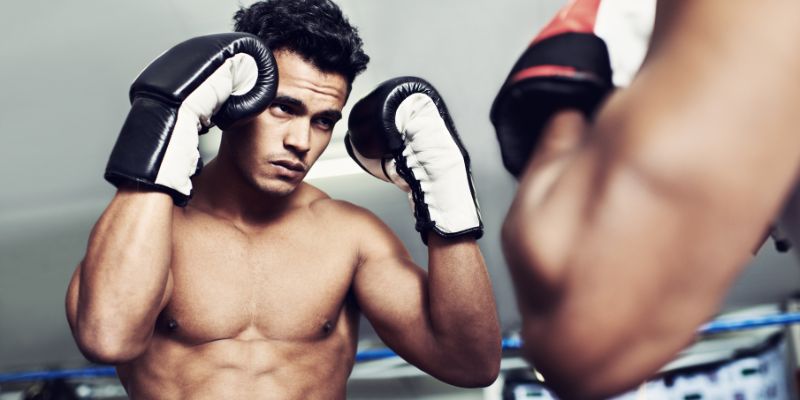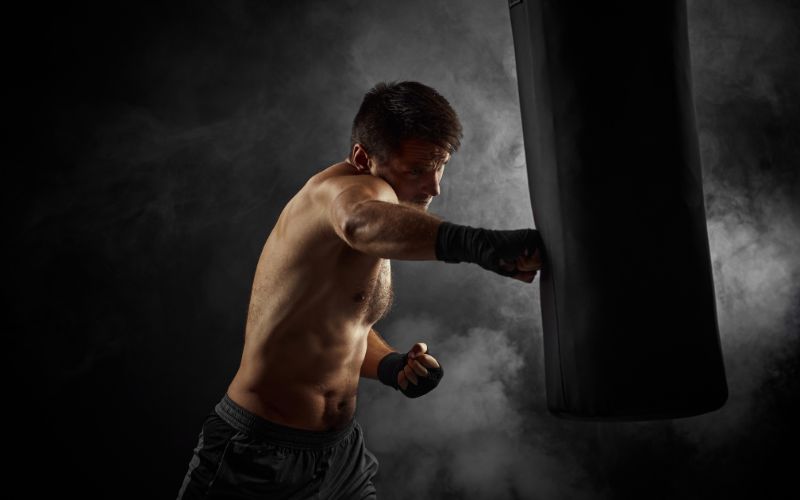In the world of boxing, a variety of punches exist, each with its own unique mechanics and purpose. One such technique, known for its effective power delivery and precision, is the corkscrew punch.
The corkscrew punch is a boxing technique where the boxer rotates their entire arm, like turning a corkscrew, as they deliver the punch. This rotation adds power and precision to straight punches, hooks, and uppercuts. It enhances impact and increases the boxer’s defensive coverage.
Alright, we’ve done the brainy bit, you now know what a corkscrew punch is! But, let’s not stop here, we’re just getting warmed up. Knowing what it is and being able to land one effectively are two different things. So buckle up, because we’re about to dive deep into all the things you need to know about the corkscrew punch.
The Origin of The Corkscrew Punch
The corkscrew punch traces its origin back to the early 20th century. It was born out of the ingenious mind of Charles “Kid” McCoy, an eminent figure in boxing history, renowned for his unorthodox fighting techniques and slick strategies.
It is believed that McCoy observed a cat playing, striking a ball of string with swift, twisting motions. He was captivated by the fluidity and speed of these strikes, realizing the potential of incorporating a similar maneuver into his boxing style.
Mimicking the cat’s movement, McCoy added a wrist twist to his punch, enhancing its effectiveness by increasing the chances of inflicting a cut on the opponent. Thus, the corkscrew punch was born, named after the spiraling motion of a corkscrew. In the era when boxing gloves offered minimal hand protection, this technique was a potent offensive weapon, capable of drawing blood and leaving lasting damage.
Although the corkscrew punch found its name and fame through McCoy, it wasn’t limited to the world of boxing. This technique found favor across various martial arts disciplines like Kung Fu, Tae Kwon Do, and Karate. Twisting the wrist during a strike is a fundamental lesson taught to martial arts students, infusing power and precision into their attacks.
The corkscrew punch has been a staple in boxing for over a century, with generations of boxers incorporating it into their fighting styles. If you’ve ever frequented a boxing gym, you’re likely familiar with the trainers instructing their students to ‘turn their punches over.’ This common directive is a nod to McCoy’s corkscrew punch, a technique that has persisted through the ages due to its effectiveness.
The legacy of the corkscrew punch extends beyond reality and into the world of fiction, finding a place in the popular manga series ‘Hajime no Ippo.’ The character Eiji Date employs this technique, targeting his opponent’s heart with a precisely aimed corkscrew punch, demonstrating its lethal potential.
Why Boxers Use The Corkscrew Punch
Although the popularity of the corkscrew punch has seemingly ebbed in recent times, it remains a potent weapon in the arsenal of those fighters who have dedicated the time and effort to master it. Over the years, this technique has led to numerous knockouts, underscoring its effectiveness in the world of combat sports.
A closer examination of the corkscrew punch reveals several reasons why boxers favor this method:
- Hand Protection: the hands of a boxer are their most vital tools, hence, protecting them from injury is crucial. The corkscrew punch, with its characteristic twist of the forearm, provides stability to the wrist, reducing the risk of injury during an offensive. The rotation aligns the knuckles with the target, ensuring the initial contact reduces the impact on the rest of the hand.
- Chin Protection: the mechanics of throwing a corkscrew punch involve a natural elevation of the shoulder, creating a barrier that shields the chin from counterattacks.
- Improved Defensive Posture: the corkscrew punch inherently requires a boxer to adopt a certain angle, creating an element of unpredictability that can confound an opponent’s attempt to land a counter punch. The key, however, is moderation; predictability of any kind can make a boxer vulnerable.
- Increased Damage: in the contemporary boxing landscape, where gloves provide significant hand protection, the corkscrew punch may not effectively open up cuts as it once did. However, its inherent power is still capable of inflicting devastating damage on opponents.
- Increased Power & Wrist Protection: The corkscrew punch employs a sideways wrist position, creating a stable base for a power-packed punch while offering protection to the wrist.
Ultimately, while the effectiveness of the corkscrew punch may vary among boxers, those who have mastered this technique have repeatedly demonstrated its potential to deliver stunning blows.
The corkscrew punch allows fighters to balance the scales between offensive power and defensive protection. This dynamic blend of power, speed, and protection is the reason why the corkscrew punch continues to be a formidable technique in the boxing world.
Mechanics of The Corkscrew Punch
The corkscrew punch is a complex yet highly efficient technique widely used in boxing. Its potency is derived from the specific mechanics employed when delivering it. The punch’s fundamental principles hinge on two key aspects: the power from the forearm, and the rotation of the entire arm.
Firstly, engaging the forearm in the process of delivering a punch is crucial to its strength. This principle holds that your elbow should align with your wrist when throwing the punch. The elbow and forearm play an integral role in determining the power of the punch. If they are not lined up with your wrist during a strike, the effectiveness of the punch dramatically decreases.
While throwing a punch, it is essential that your elbows move in accordance with the line of your wrist. In a jab, for instance, your elbows should shoot forward, and in a hook, they should swing across. Meanwhile, during an uppercut, your elbow should move upward, parallel to your wrist. The elbow’s trajectory determines the punch’s direction and ultimately, the effectiveness of the corkscrew motion.
The second key principle of the corkscrew punch lies in the rotation of the entire arm, from the shoulder to the fist. This technique starts with your palms at a horizontal angle, with your palms facing downward. The rotation of your arm activates your elbow and facilitates a natural corkscrew motion. The corkscrew motion is dynamic, not static, meaning that it involves rotation, not just positioning.
The basic boxing stance maintains your elbows downward to cover your body, and your palms typically face sideways or inwards towards your face. The corkscrew punch technique allows you to punch from this defensive position, enabling your elbow to shift from pointing downwards to quickly lifting upwards and rotating into your punch for maximum power.
A vital advantage of the corkscrew punch is that it engages your shoulder, which in turn provides protection for your chin during the punch. A direct comparison of a vertical-fist punch versus a corkscrew punch demonstrates that your shoulder covers more of your chin with the latter, reducing your exposure to counterpunches.
The technique also presents the potential to bypass an opponent’s guard. In some instances, like with the overhand right, it may be impossible to loop over your opponent’s defense with your elbow pointing down. In such cases, employing a corkscrew punch can facilitate your fist to come around the guard and downwards at his face.
The final key to mastering the corkscrew punch is to think about the entire arm, not just the fist. Feel the quick rotation in your elbow and shoulder. Your arm should be relaxed and capable of snapping into place with the corkscrew motion. It should not feel like an energy-consuming process, but a fast, easy way to move your elbow from a defensive position to a punching position.
For maximum effectiveness, engage the larger muscles of your body. Initiate the corkscrew effect from your shoulders and lat muscles rather than just your forearm. This coordination of the larger muscles results in a stronger, more powerful corkscrew punch.
In summary, the mechanics of the corkscrew punch are rooted in a careful application of power from your forearms, as well as an effective rotation of your entire arm. It is a motion, not a position, that requires the harmonious operation of your entire arm and larger muscles.
This powerful technique is instrumental in delivering powerful punches while protecting your chin and enabling you to counteract your opponent’s defense.
How to Use The Corkscrew Punch
Leveraging the corkscrew punch technique in boxing requires understanding and application of various punch types. Here’s a guide to help you incorporate this powerful move into your boxing repertoire.
Applying Corkscrew Punch Technique in Straight Punches
Straight punches are the fundamental building blocks in boxing – the jab and straight right. The implementation of the corkscrew punch technique for these punches is straightforward. As you extend your fist forward for the punch, rotate your entire arm simultaneously.
The key is to have your palm facing down as the punch lands, turning it from the vertical plane to the horizontal. This twisting motion, combined with the power from your forearm and shoulder, infuses the punch with more power and precision.
Integrating Corkscrew Punch Technique in Head Hooks
Head hooks, including the left hook or overhand right, can greatly benefit from the corkscrew punch technique. As you swing the hook, rotate your entire arm.
The aim is to make your punch land with your elbow at the same level as your fist (in the case of hooks) or higher than the fist (in the case of overhands). The rotation, if done correctly, enhances the strength of your punch while offering protection to your chin.
Executing Corkscrew Punch Technique in Uppercuts
Incorporating the corkscrew technique in uppercuts presents a unique challenge because it involves a reverse motion. Instead of the usual outward rotation, an uppercut calls for an inward rotation of your entire arm.
Consequently, your punch will land with your elbow moving inwards to support the uppercut. The inward rotation also gives a different angle to your punch, allowing for tighter and more powerful uppercuts. However, using this technique on every uppercut might not be the best strategy; reserve it for close-range combat when you need to deliver tight uppercuts from the inside.
How to Set Up The Corkscrew Punch

The set-up of a corkscrew punch is an essential aspect to focus on when learning this powerful boxing technique. First, let’s clarify that all power in boxing begins from the ground up. This means the feet are crucial for setting the stage for any punch, especially the corkscrew punch.
As you prepare to deliver a corkscrew punch, your body must be firmly grounded. Your feet should be well-positioned, and your balance needs to be perfect. You’re aiming to rotate your entire body to generate the maximum amount of power when delivering the punch. Imagine your body as a powerful spring, uncoiling to release an enormous amount of force.
When aiming your corkscrew punch, consider targeting the chest, abdomen, and vital areas such as the liver and spleen. A well-placed punch to these areas can shock your opponent’s body and possibly knock them off balance, opening the field for further punches.
Start with your shoulder anchored behind your hip for maximum impact value. As you rotate your body, your shoulder comes into play. The rotation should send a significant amount of force from your hip into the punch, maximizing the impact on the target.
An example of a corkscrew punch combo can start with a jab. From your grounded position, rotate into a reverse or power punch. This rotation is the first part of the corkscrew setup, as you’re starting the body rotation needed for a powerful corkscrew punch.
Once you’ve delivered the reverse punch, rotate back into a hook. This is the second part of the corkscrew set-up, continuing the body rotation that started with the reverse punch.
Finally, you can execute the corkscrew punch. Rotate back over the top, letting your body whip around like a spring releasing its tension. This rotation should drive all your weight and power into the punch, ensuring it delivers the maximum amount of impact.
So, the sequence of a corkscrew punch set-up is like this: One, throw a jab. Two, rotate into a reverse punch. Three, rotate back into a hook. Four, rotate over the top into the corkscrew punch. Your hips should do a lot of the work in this sequence, helping to generate the power needed for a potent corkscrew punch.
The key is to keep everything working in unison. Your body should move together as one powerful unit, with each part contributing to the overall force of the punch. Practice this sequence until it feels smooth and natural, and you’ll be well on your way to mastering the corkscrew punch.

